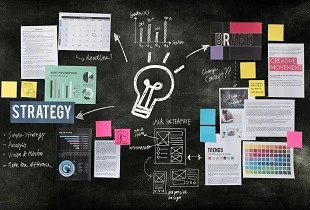Chart your path to operational excellence success in 2023
Visualize the year ahead with this comprehensive map of 2023’s biggest OPEX trends including consumer driven business, organizational resiliency and sustainability
Add bookmark
Market turmoil, inflation and widespread supply chain disruption, among other factors, made 2022 a challenging year that developed differently than expected. The economic situation forced many companies to strengthen their business transformation initiatives.
As operational excellence will remain a top priority for most companies, we, Software AG, wanted to share the top OPEX trends and topics that will define 2023.
Webinar: Must-Know Trends for Operational Excellence in 2023
Since operational excellence has many objectives and subtopics, we created a trend map to bring transparency into this landscape. Like a subway map, the lines are the primary navigation elements, representing the core topics. The “stops” are important trends. At major intersections, the core topics meet and influence each other. Let us take a closer look at some of the most important trends below.

Economic uncertainty shifts the focus to resilience and effectiveness
Against the backdrop of geopolitical risks, high inflation rates and energy prices, economic uncertainty will accompany us for some time to come. Companies have been forced to adapt their supply relationships and ecosystems and, in some cases, their entire business model–leading to a massive adaptation of the operating model and subsequently the business processes. Even though supply chains are currently returning to normal, management is reacting to this uncertainty by shifting the focus (and budgets) on making processes resilient, and thus business resilience has become a major objective of operational excellence.
The objective is to be prepared for possible threats, such as supply chain disruptions, natural disasters, cyber attacks or even the Covid-19 aftershock. Resilience means “the ability of an organization to adapt rapidly to changing environments and unforeseen events”. There is a large overlap between operational risk management and operational excellence: standards such as ISO 22301 for business continuity management systems require transparency about business processes, data, IT systems and responsibilities to define priorities and plan B scenarios.
Compliance mandates are evolving
Compliance requirements continue to grow. The following sub-trends can be observed:
- Compliance requirements increasingly go beyond the boundaries of the own company. For example, the German Supply Chain Act (soon to be followed by a European initiative) requires risk analysis regarding compliance with human rights, fair labor practices and environmental protection requirements along the entire supply chain since January 2023.
- Companies increasingly understand that it is counterproductive to set up a dedicated management system for every compliance topic (quality, data security, environmental protection, etc.) and, since the same aspects (processes, data, IT systems, etc.) always form the basis, it makes sense to set up an integrated management system that maps the various topics in an integrated manner.
- Compliance and audit management is very often still determined by a multitude of manual activities. The degree of automation will now experience a leap upwards, as process monitoring allows compliance rules to be monitored automatically as well.
Process mining becomes omnipotent
Especially in large companies, the adoption rate of process mining is already at a high level. Process mining becomes a mandatory technology to be competitive in any industry. This year mining technologies will expand to even more aspects of the organization.
On one hand, as a use case, compliance monitoring is becoming just as important as process optimization. On the other hand, we are seeing production-related processes being optimized by closing the gap between IT and operational technology (OT). The trend toward cross-company process management is supported by process mining technologies by analyzing and optimizing end-to-end supply chains and distribution networks.
Sustainability is an economic factor
Sustainability can be seen as another compliance requirement, but its significance and impact are even more far-reaching. Nowadays, sustainability is an important economic factor, and the topic has reached the board level at all organizations.
Ultimately, it is about ensuring the sustainability of all business operations and processes. This means that the classic goals of process optimization, such as increased speed, cost-effectiveness, and quality, are expanded to include additional objectives such as CO2 emissions, resource consumption and working conditions.
Appropriate reporting must be established to take these objectives into account. There are many sustainability standards and frameworks (such as ISO 14001 for Environmental Management Systems, ISO 26000 for social responsibility) that can be look towards for inspiration.
Process management becomes a consumer’s world
The employees' perspective and the question of how work is being organized in the future also play an important role for operational excellence initiatives 2023. There are many surveys about where people want to work in the future all emphasizing that work from home and hybrid work is here to stay. As a result, the obvious challenge is to ensure that all employees know the best way of working, what tasks they are responsible for, and the relevant policies and standard operating procedures.
Going forward, process management will support the role of information consumers much more than before. The objective will be to take each individual employee into account and make sure they have all the information they need for their specific role and daily work.
We need to take on the consumer's perspective to understand what kind of information is needed and what kind of presentation or visualization is most suitable. The classic expert-like representations are transformed into checklists, videos and other media that can be used on-the-job. To put this into practice, a smooth lifecycle will be established, from the creation and dissemination of information to consumption, feedback, and exchange between colleagues.




















































